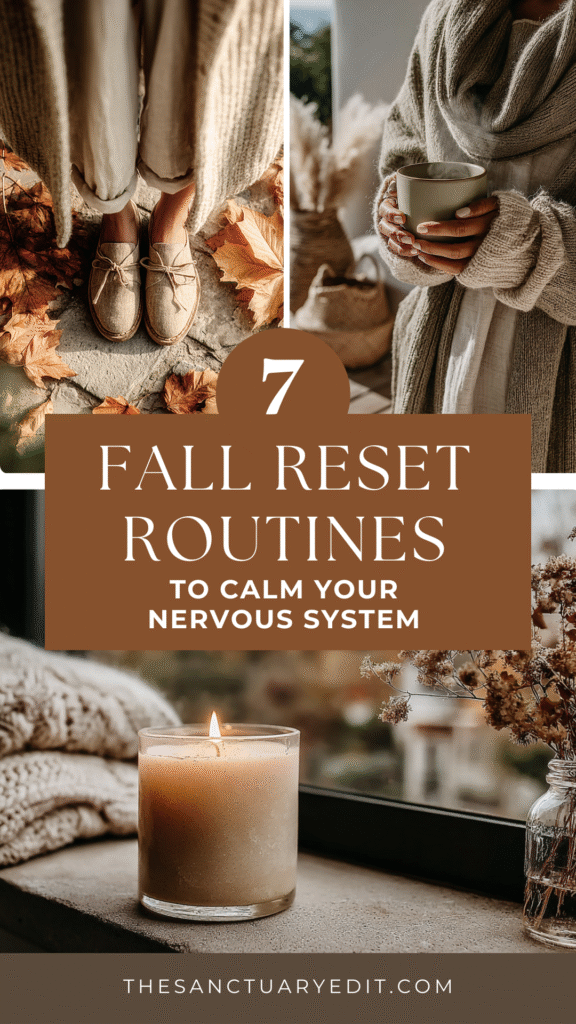This post may contain affiliate links, including those from Amazon Associates. If you make a purchase through these links, I may earn a commission at no additional cost to you. Learn more about our affiliate policy.
The shift into fall often carries both beauty and tension.
The air turns cooler, leaves turn golden, and routines return after the looseness of summer.
Yet with the seasonal change comes a new kind of pressure: more structure, shorter days, and the quiet hum of nervous system fatigue.
You may notice yourself feeling less regulated, more easily drained, or pulled into the swirl of busyness that autumn tends to bring.
Slow, intentional resets can help. Fall is a natural time to re-anchor, to create gentle rhythms that support your body and mind.
These seven routines are designed to help your nervous system settle, offering you a way to feel grounded and steady as the season unfolds.
Re-establish Daily Rhythms

One of the simplest ways to bring calm is through rhythm.
Your nervous system feels safest when it can predict what comes next. Summer often brings late nights, travel, and looser schedules.
By fall, returning to steadier rhythms helps your body and mind exhale.
Start small. Choose a wake time that feels supportive and keep it steady, even on weekends.
Align your meals to regular windows. Anchor your day with one or two rituals you can count on, such as making tea in the morning or lighting a candle at night.
These cues remind your system that it can relax because the day carries a familiar flow.
Move in Quiet Embodiment
Stress often lingers in the body long after the mind has moved on.
Shoulders stay tight, the jaw clenches, the stomach feels unsettled. Gentle movement helps release these patterns, guiding your body back toward calm.
In autumn, think less about workouts and more about embodied practices.
A few minutes of yoga, tai chi, or slow stretching on the floor can be enough.
Walk barefoot across cool grass or a wooden floor and notice each step. Give yourself permission to sway, stretch, or curl up slowly, movements that remind your body it is safe to soften.
You don’t need an hour-long practice. Even two minutes of mindful movement shifts your nervous system toward rest.
Walk or Pause Outside in Seasonal Stillness

Fall carries its own sensory medicine. The sound of leaves underfoot, the crispness of the air, the lower angle of golden light, all offer natural grounding. Nature, even in brief doses, is one of the most effective ways to soothe an overstimulated nervous system.
Try stepping outside for five minutes each day without a goal. Leave your phone inside.
Notice the scents of the season: the faint woodsmoke, the dampness of earth, the sweetness of apples.
Let your eyes rest on trees shifting color. These moments don’t have to be long to be meaningful. They remind your nervous system that it belongs to something steady and enduring.
Light a Candle or Tend a Hearth
Humans are wired to find comfort in firelight. The flicker of a flame, whether from a fireplace or a simple beeswax candle, signals warmth and safety deep in the nervous system.
Watching a flame can reduce anxiety, quiet the mind, and create a ritual of closure at day’s end.
Choose one candle to light each evening as a reset. Place it in the center of your table, beside your bath, or on a windowsill.
Take a few breaths as you watch the flame dance. This is less about the candle itself and more about what it represents, a transition, a cue for your body to release the day.
Over time, the ritual becomes a kind of doorway into calm.

Pause with Deep, Vagal-Activating Breath
Breath is one of the fastest ways to reset your nervous system. Long, steady exhales activate the vagus nerve, which signals your body to move out of fight-or-flight and into rest-and-digest.
In the fall, as days shorten and schedules tighten, carving out small breathing pauses can keep your nervous system balanced.
Try the physiological sigh: take two quick inhales through the nose followed by one long exhale through the mouth.
Repeat this two or three times to release tension. Or practice a simple 4-7-8 pattern: inhale for four, hold for seven, exhale for eight.
Even a few minutes before bed or between tasks can shift you from frazzled to steady.
Ground with Gentle Sensory Rituals

The nervous system responds directly to sensory input. When you feel scattered, grounding through touch, scent, or sound can help bring you back into the present. Fall lends itself beautifully to these rituals.
Wrap yourself in a soft wool or linen blanket and notice its weight.
Sip something warm, paying attention to the taste and aroma.
Hold a stone or pinecone in your hand and let its texture bring you back to your body. Burn cedar or diffuse clove and orange oil for a grounding seasonal scent.
These sensory cues tell your nervous system where it is: safe, here, now. They cut through overwhelm without requiring effort or thought.
Journal One Quiet Thought or Gratitude
When your mind is crowded, your nervous system follows.
Writing is a simple way to clear space and signal to your body that it can rest. Journaling doesn’t have to mean long entries or polished reflections. A single line is enough.
At the end of the day, take out your journal and complete one of these sentences: “Tonight I release…” or “Today I am grateful for…”
This short practice allows you to close the loop on your day, giving your mind a place to rest. Over time, these single sentences build into a gentle archive of calm.
If writing doesn’t call to you, try sketching a small symbol, or simply naming one thing aloud that you’re thankful for. The act of expression matters more than the form.
Weaving These Routines Together
A fall reset doesn’t mean reinventing your life. It means choosing a handful of rituals that help you regulate and anchor as the season shifts. You don’t need to adopt all seven at once. Begin with the one that feels easiest.
Maybe it’s lighting a candle at night, or stepping outside each morning for five minutes.
Once a practice feels natural, layer in another. The power of slow living is not in doing more, but in doing what feels meaningful and sustainable. These routines aren’t chores to check off; they are invitations to return to yourself.
Fall can feel busy, but it can also feel steady. By weaving in gentle resets, you create a season that not only looks beautiful but feels safe and restorative from within.
Closing Encouragement
Your nervous system longs for cues of safety, rhythm, and care.
Fall offers the perfect canvas to create them. Through small, intentional routines like breathing deeply, stepping outside, lighting a candle, writing one quiet though, you remind your body that calm is available, even in the midst of transition.
Let this season be less about pushing through and more about grounding down. Start with one reset ritual this week. Let it steady you. Over time, these gentle practices will carry you through autumn with more ease, warmth, and peace.


